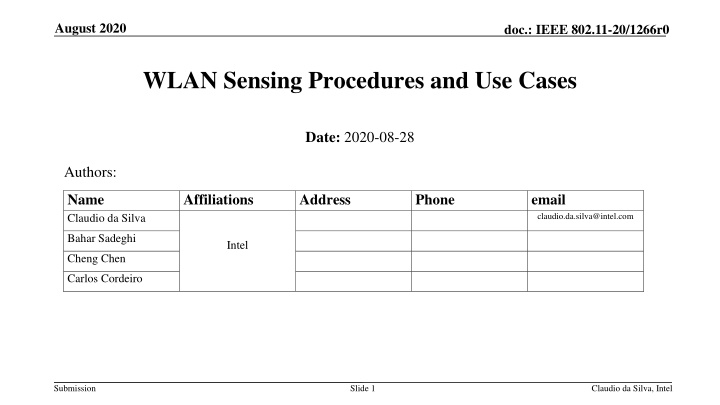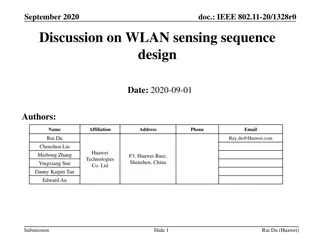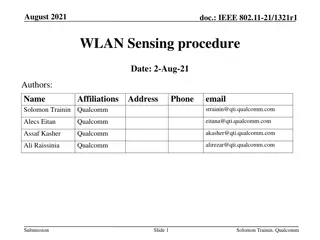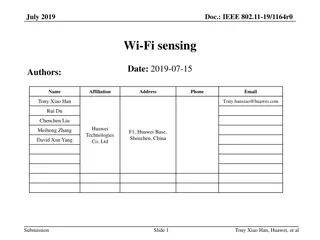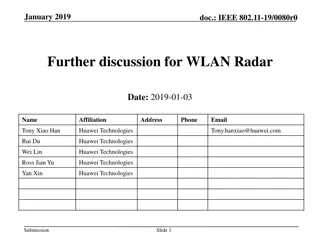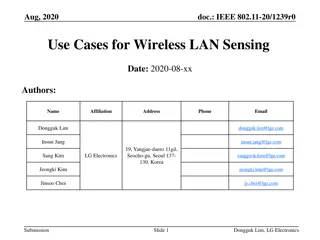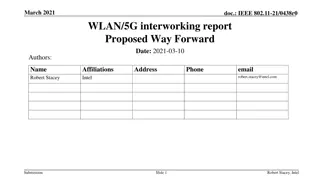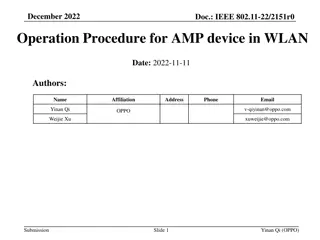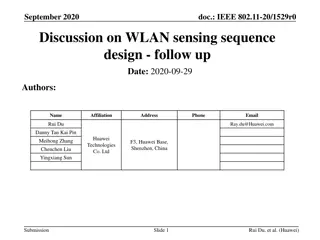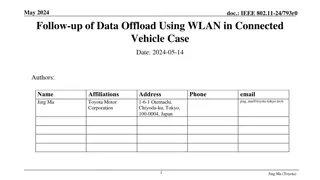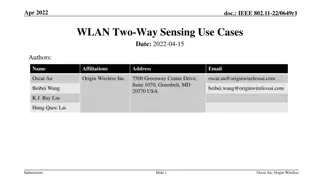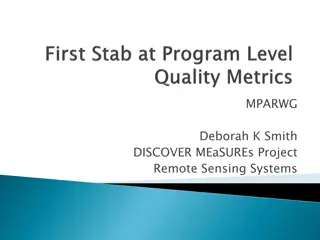WLAN Sensing Procedures and Use Cases
This document discusses WLAN sensing procedures with different types of initiators (AP STA and non-AP STA) and explores various use cases such as home environments and enterprises. It covers potential procedures for multiple sensing responders and provides conclusions based on the outlined scenarios.
Download Presentation

Please find below an Image/Link to download the presentation.
The content on the website is provided AS IS for your information and personal use only. It may not be sold, licensed, or shared on other websites without obtaining consent from the author.If you encounter any issues during the download, it is possible that the publisher has removed the file from their server.
You are allowed to download the files provided on this website for personal or commercial use, subject to the condition that they are used lawfully. All files are the property of their respective owners.
The content on the website is provided AS IS for your information and personal use only. It may not be sold, licensed, or shared on other websites without obtaining consent from the author.
E N D
Presentation Transcript
August 2020 doc.: IEEE 802.11-20/1266r0 WLAN Sensing Procedures and Use Cases Date: 2020-08-28 Authors: Name Claudio da Silva Affiliations Address Phone email claudio.da.silva@intel.com Bahar Sadeghi Intel Cheng Chen Carlos Cordeiro Submission Slide 1 Claudio da Silva, Intel
August 2020 doc.: IEEE 802.11-20/1266r0 Abstract We first discuss WLAN sensing procedures in which the sensing initiator is an AP STA and review possible use cases. We then review WLAN sensing use cases where the sensing initiator is a non-AP STA. Potential procedures to enable sensing with multiple sensing responders for cases where the sensing initiator is a non-AP STA are discussed. Submission Slide 2 Claudio da Silva, Intel
August 2020 doc.: IEEE 802.11-20/1266r0 Outline Abstract and outline Sensing initiator is an AP STA Use cases Sensing initiator is a non-AP STA Use cases Procedures to support multiple sensing responders Conclusions Submission Slide 3 Claudio da Silva, Intel
August 2020 doc.: IEEE 802.11-20/1266r0 Sensing Initiator is an AP STA Possible procedure: Sensing initiator (AP STA) obtains measurements using one or more sensing responders (clients/non-AP STAs) that are associated with it. WLAN sensing capabilities exchanged during the association process. AP obtains measurements dynamically or through a schedule. Sensing transmitter(s) could be the sensing initiator (feedback required) or sensing responders. Note: We consider the unassociated case later in the contribution. From [1]: Sensing initiator: A STA that initiates a WLAN sensing session Sensing responder: A STA that participates in a WLAN sensing session initiated by a sensing initiator Sensing transmitter: A STA that transmits PPDUs used for sensing measurements in a sensing session Sensing receiver: A STA that receives PPDUs sent by a sensing transmitter and performs sensing measurements A sensing session is an instance of a sensing procedure with the associated scheduling if applicable, and operational parameters of that instance Sensing Initiator (AP) Sensing Responder (client) Sensing Responder (client) Sensing Responder (client) ... ... Note: In this presentation, we consider multi-static architectures only. Submission Slide 4 Claudio da Silva, Intel
August 2020 doc.: IEEE 802.11-20/1266r0 Sensing Initiator is an AP STA: Use cases 1/2 Set of use cases 1: Home environment. Makes use of clients found in various locations inside the house. Measurements are taken with multiple clients, which could be used to characterize different rooms and floors. High level of device diversity. Wide coverage. Sensing applications include: Security and safety. See, for example, [2]. Energy management and control. Clientless positioning. Submission Slide 5 Claudio da Silva, Intel
August 2020 doc.: IEEE 802.11-20/1266r0 Sensing Initiator is an AP STA: Use cases 2/2 Set of use cases 2: Enterprise. Example enterprise environment: Each color-coded area corresponds to the coverage/sensing area of an AP; measurements obtained by an AP roughly characterizes its coverage area. Makes use of APs and clients found in various locations in the environment. High level of device diversity. Sensing applications include: Security and safety; energy management and control; clientless positioning. Space-usage analytics. Smart housekeeping (hotels, for instance). Submission Slide 6 Claudio da Silva, Intel
August 2020 doc.: IEEE 802.11-20/1266r0 Outline Abstract and outline Sensing initiator is an AP STA Use cases Sensing initiator is a non-AP STA Use cases Procedures to support multiple sensing responders Conclusions Submission Slide 7 Claudio da Silva, Intel
August 2020 doc.: IEEE 802.11-20/1266r0 Sensing Initiator is a non-AP STA: Use-cases 1/2 Sensing initiator is a non-AP STA Sensing transmitter(s) could be the sensing initiator (feedback required) or sensing responders. Use cases: Proximity detection Wake-up: Detection of a user approaching the system, enhanced user experience. Security: Detection of a user walking away from the system, power save and security. Presence detection Detection of a potential user in proximity to the device. Bandwidth management: Pause and/or lower resolution of streaming content based on the detection of presence/absence of a user. Claudio da Silva, Intel Submission Slide 8
August 2020 doc.: IEEE 802.11-20/1266r0 Sensing Initiator is a non-AP STA: Use-cases 2/2 https://www.newswire.com/news/touchles s-design-initiative-will-create-touchless- kiosks-for-museums-21174838 Multi-user presence detection Example Security: System identifies the presence of a user and tracks it over time. Presence of a second user is detected, and system notifies the user. Touchless interaction Detection of gestures performed by a user in proximity to the device. Gestures could be as simple as left/right for page sweep or as complex as (touchless) handwriting. Claudio da Silva, Intel Submission Slide 9
August 2020 doc.: IEEE 802.11-20/1266r0 Sensing Initiator is a non-AP STA: Single STA Sensing initiator (non-AP STA) obtains measurements using the AP (sensing responder) that it is associated with. WLAN sensing capabilities could be exchanged during the association process. Client can trigger transmissions from sensing responders dynamically or through a schedule. Sensing transmitter could be the client (AP would be the sensing receiver, feedback required) or the AP (client would be the receiver). Sensing Responder (AP) Low level of device diversity. Only one sensing responder is used. MIMO transmissions could be used, to a certain extent, to increase diversity. Device diversity further enhance WLAN sensing and could be required to support certain applications. Sensing Initiator (client) Note: We consider the unassociated case later in the contribution. Claudio da Silva, Intel Submission Slide 10
August 2020 doc.: IEEE 802.11-20/1266r0 Experimental Results ([3] and [4]) As discussed in detail in [3] and [4], we performed experiments to evaluate the use of WLAN sensing to detect motion and identify where (e.g., in which room) it happens. For ease of presentation and analysis, only three STAs are considered: STA O, STA PR, and STA B1. predicted actual Single sensing transmitter (STA B1) Two sensing transmitters (STA PR and STA B1) Example Confusion matrix: The system mistakes movement in the play room as movement in bedroom 1 with a probability equal to 0.0263. Claudio da Silva, Intel Submission Slide 11
August 2020 doc.: IEEE 802.11-20/1266r0 Sensing Initiator is a non-AP STA: Multiple Responders Scenario: Client establishes multiple sensing sessions with other APs (that is, APs other than the one to which the client is associated with). APs must have the appropriate capability/functionality and be able to support the request. Requires negotiation of parameters and scheduling, for example. (unassociated) (associated) (unassociated) Sensing Responder (AP) Sensing Responder (AP) Sensing Responder (AP) Sensing Initiator (client) If MAC-level security is a requirement (e.g., use of protected management frames), a security context could be established by using PASN (pre-association security negotiation). Procedure defined by TGaz. Claudio da Silva, Intel Submission Slide 12
August 2020 doc.: IEEE 802.11-20/1266r0 Sensing Initiator is a non-AP STA: Multiple Responders control 802.11be is currently working on a multi-AP feature. Different models and functionalities are being considered. Sensing Responder (AP) Sensing Responder (AP) Sensing Responder (AP) WLAN sensing could re-use multi-AP procedures or, if needed, define modifications necessary to allow for a client to obtain measurements using multiple APs. measurements Sensing Initiator (client) Note: The multi-AP feature can also be used to enhance WLAN sensing when the sensing initiator is an AP STA. Claudio da Silva, Intel Submission Slide 13
August 2020 doc.: IEEE 802.11-20/1266r0 Sensing Initiator is a non-AP STA: Multiple Responders 802.11be is also currently working on enabling peer-to-peer (P2P) frame exchange. AP shares time resources obtained in a TXOP for P2P frame exchanges. AP control WLAN sensing could re-use P2P or, if needed, define modifications necessary to allow for a client to obtain measurements using PPDUs transmitted by other clients. Sensing Responder (client) Sensing Initiator (client) Note: WLAN sensing based on P2P-like procedures are particularly advantageous in scenarios where only one AP STA is present. measurements Claudio da Silva, Intel Submission Slide 14
August 2020 doc.: IEEE 802.11-20/1266r0 Outline Abstract and outline Sensing initiator is an AP STA Use cases Sensing initiator is a non-AP STA Use cases Procedures to support multiple sensing responders Conclusions Submission Slide 15 Claudio da Silva, Intel
August 2020 doc.: IEEE 802.11-20/1266r0 Conclusions The sensing initiator is an AP STA and sensing initiator is a non-AP STA configurations have unique characteristics and standard requirements. Since there are use cases of value for both configurations, the WLAN Sensing amendment should support both. The three procedures here discussed for client-based sensing are not the only/ best procedures possible. More work is needed, and SENS SG members are encouraged to contribute to the discussion. Example: When looking into 11be features such as multi-AP and P2P, timelines and dependency between 11be and 11bf must be considered. Submission Slide 16 Claudio da Silva, Intel
August 2020 doc.: IEEE 802.11-20/1266r0 SP Do you agree that support of both sensing initiator is an AP STA and sensing initiator is a non-AP STA applications should be a functional requirement of a WLAN sensing amendment? Submission Slide 17 Claudio da Silva, Intel
August 2020 doc.: IEEE 802.11-20/1266r0 References [1] 20/0807r3, WLAN Sensing Definitions [2] Wireless Broadband Alliance, Wi-Fi Sensing Group, whitepaper, Oct. 2019 [3] 19/1416r0, Wi-Fi Sensing: Cooperation and Standard Support [4] 19/1772r0, Presence and Proximity Detection Using WLAN Sensing Submission Slide 18 Claudio da Silva, Intel
